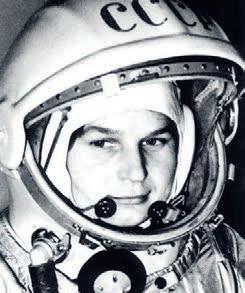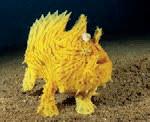UNKNOWN INTO THE
EXPLORING COURAGEOUS CREWS, CURIOUS CREATURES AND INCREDIBLE COUNTRIES















 YOUR PHOTOS.
YOUR PHOTOS.

EXPLORING COURAGEOUS CREWS, CURIOUS CREATURES AND INCREDIBLE COUNTRIES















 YOUR PHOTOS.
YOUR PHOTOS.

Astronauts and lifeboat crew have a lot in common. A cool head? Check. Bags of courage? Check. Lifesaving equipment? Check. A rock-solid team? Check. It’s no surprise really – it takes a special kind of person to launch into the unknown

Being underwater is the closest thing to being in space, so, just like RNLI crew, astronauts train in a pool. astronauts get to feel what it’s like to go on a spacewalk and practise how to fix things, like the submerged replica of the International Space Station. NASA’s* underwater lab is the world’s largest swimming pool big enough to fit nine Olympic-sized pools in!

RNLI crew have a pretty impressive pool of their own: the state-of-the-art Sea Survival Centre can create waves and even a storm.

*National Aeronautics and Space Administration (the US government agency that is responsible for science and technology in air and space).

Did you know that without the Moon there would be no tides? As it orbits the Earth, the Moon’s gravity pulls the oceans towards it, causing a bulge, or high tide, on the side of the Earth closest to the Moon. High tides draw water away from the rest of the oceans, causing low tides.

Whether you’re launching into outer space or the Outer Hebrides, it’s important to have a dependable team around you. When there was an explosion on Apollo 13 on its way to the Moon, the team at Mission Control helped to get the astronauts back safely, with the help of some duct tape and one of the astronaut’s socks to make an emergency air filter!

RNLI crew members rely on a trusty backup team too
including shore crew who help to get the lifeboats in and out of the water. Rocket launches are planned years in advance, but RNLI crew have to be ready at a moment’s notice – the average lifeboat launch takes just 10 minutes. Beat that, NASA!
The Moon is important for another reason. Astronauts are due to return there in 2025 on the Artemis mission. Artemis is the Greek goddess of the Moon and twin sister of Apollo, the name of the original Moon programme. Eventually, astronauts will build a moonbase that will help humans prepare for a mission to Mars!

'HOUSTON, WE HAVE A MISSING SOCK'
One of the reasons that the next Moon mission is named after a goddess is that it will see the first woman walk on the Moon. But the first woman in space was Valentina Tereshkova, in 1963. Pioneers like Valentina paved the way for future generations.

Another pioneer was Elisabeth Hostvedt, who in 1969 became the first fully qualified female lifeboat crew member. More recently, Di Bush became the RNLI’s first female coxswain. That means she commands Harwich RNLI’s all-weather lifeboat, Albert Brown. High five Di!

DID YOU KNOW?
LAST YEAR 20-YEAR-OLD GEORGE ‘CHAD’ YEOMAN BECAME RNLI SALCOMBE’S YOUNGEST LIFEBOAT HELM



In the search for extraterrestrial life (aliens), scientists and engineers have sent spacecraft to every planet in our solar system, and beyond. It’s a field of science called astrobiology, and there’s a robotic rover exploring Mars right now, with the help of a little helicopter called Ingenuity In fact, we know more about Mars than our oceans!
More than 80% of our oceans remain unexplored. If Mount Everest were placed in the deepest part –the Mariana Trench – its peak wouldn’t even peek above the surface. Who knows what alien-looking creatures are lurking down there?

Astronauts and lifeboat crew have a language all their own. Here’s your jargon-buster.
EMU
PUFFY HEAD BIRD LEGS
When astronauts get a congested head and wobbly legs due to loss of gravity
ILB
Inshore
ALB
All-weather lifeboat
T-MINUS
The countdown time remaining until a rocket launch
Combine your favourite colour with the month you were born:
RED BLAZE
BLUE ACE
GREEN NEWT
YELLOW HERSHEY
PINK PLUCKY
PURPLE EYEBALL
BLACK SPARKY
GOLD DALLAS
SILVER SKIPPO
ORANGE MOXIE
INDIGO SCREECH
WHITE MOONBEAM
Astronaut first name …………..…...

JANUARY LIGHTSPEED
FEBRUARY NOVA
MARCH JETPACKER
APRIL NEPTUNE

MAY BOOMER
JUNE ACER
JULY GORDON
AUGUST WINGWALKER
SEPTEMBER JUNO
OCTOBER QUASAR
NOVEMBER STARDUST


DECEMBER JENSEN
Astronaut second name
Both sets of crew have to withstand an uncomfortable ride. During launch, astronauts experience g-force – extra pressure on their bodies due to acceleration and the effect of gravity. And although our all-weather lifeboats don’t go into space, they can still hit some pretty scary waves. Special shockabsorbing seats help to lessen the impact for the crew.
Extra-vehicular Mobility Unit (a flashy name for a spacesuit)
HELM
The person in charge of an inshore lifeboat


These are all real nicknames. But which crew do they belong to – NASA or RNLI? Draw a line between each name and the ship they belong to.

Some of these out-of-this-world creatures really do live on our planet. Some are made-up. Tick the ones you think are real.








